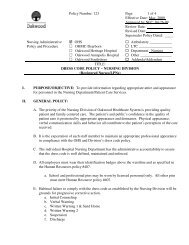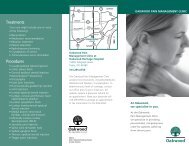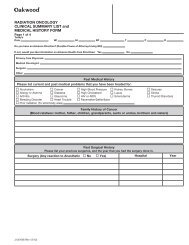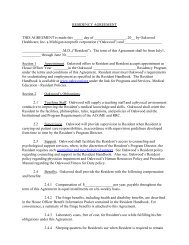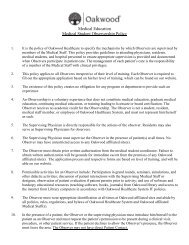OAKWOOD BARIATRIC OPTIONS - Oakwood Healthcare System
OAKWOOD BARIATRIC OPTIONS - Oakwood Healthcare System
OAKWOOD BARIATRIC OPTIONS - Oakwood Healthcare System
You also want an ePaper? Increase the reach of your titles
YUMPU automatically turns print PDFs into web optimized ePapers that Google loves.
The team that heads up <strong>Oakwood</strong> Bariatric<br />
Options is highly qualified. These leaders have a<br />
wealth of experience working with obese patients,<br />
treating the whole patient and not just one specific<br />
health problem.<br />
The <strong>Oakwood</strong> Bariatric Options team can be<br />
reached at 313.982.5288.<br />
– before<br />
Daniel Bacal, MD FACS<br />
Medical Director<br />
Bariatric Surgeon<br />
Edward Mavashev, MD<br />
Bariatric Surgeon<br />
Terry Marentette, RN<br />
Nurse Coordinator<br />
Nicolle Bacal, RN BSN<br />
Bariatric Nurse<br />
Lindsey Guerrerio, RD<br />
Dietitian<br />
Amy McGuire<br />
Office Manager<br />
If you would like to make a referral, or have a patient<br />
that may benefit from attending an informational<br />
seminar, please call 800.543.WELL.<br />
Holly M.<br />
– after<br />
“After gastric<br />
bypass my<br />
diabetes went<br />
away when I<br />
lost 90 pounds.”<br />
Faye D.<br />
– after<br />
“Two years after gastric<br />
bypass I am 125<br />
pounds thinner and<br />
running circles around<br />
people twenty years<br />
younger than me.”<br />
– before<br />
<strong>Oakwood</strong> Bariatric<br />
Options<br />
<strong>OAKWOOD</strong> <strong>BARIATRIC</strong> <strong>OPTIONS</strong><br />
18101 <strong>Oakwood</strong> Boulevard<br />
Dearborn, Michigan 48124<br />
800.543.WELL<br />
www.oakwood.org<br />
1.5M1207<br />
©<strong>Oakwood</strong> <strong>Healthcare</strong> <strong>System</strong>, 2007. All rights reserved.
<strong>Oakwood</strong><br />
Bariatric Options -<br />
“Weight No Longer”<br />
If you are struggling with severe<br />
obesity and suffering from related health<br />
conditions, <strong>Oakwood</strong> Bariatric Options<br />
can help.<br />
Approximately 11-15 million Americans<br />
today are estimated to be morbidly obese.<br />
Morbid obesity is a debilitating disease<br />
of the mind, body and spirit – something<br />
that diets, medication and exercise have<br />
no lasting impact upon.<br />
Do You Suffer<br />
From Morbid<br />
Obesity<br />
Morbid obesity is a chronic condition. There is no<br />
known cure. Obesity is determined by the following<br />
factors: genetics, behavior, internally set points of<br />
weight, and eating habits. Because of these factors,<br />
the morbidly obese person loses the ability to control<br />
his or her weight.<br />
Morbid obesity is a medical term describing people<br />
who have a Body Mass Index (BMI) of 40, or a BMI<br />
of 35-40 along with significant medical problems<br />
caused or exacerbated by weight. These medical<br />
problems include:<br />
• High Blood Pressure<br />
• Heart Disease<br />
• Diabetes<br />
• Sleep Apnea<br />
Now there is an answer: weight<br />
loss surgery.<br />
<strong>Oakwood</strong> Bariatric Options offers a<br />
surgical solution that is proven effective.<br />
It will change your life and reduce the<br />
risk of developing life-threatening<br />
diseases such as diabetes, cancer or<br />
heart disease.<br />
• High Cholesterol<br />
• Esophageal Reflux<br />
• Infertility<br />
• Joint Disease<br />
• Loss of Bladder Control<br />
• Reduced Life Expectancy<br />
What is Bariatrics<br />
Bariatrics is the field of medicine that focuses<br />
on the treatment and control of morbid obesity.
Patient Criteria Before Surgery<br />
To qualify for weight reduction surgery the patient<br />
should have a:<br />
• Body Mass Index (BMI) of 40 or higher.<br />
• BMI of 35 or higher, and obesity related<br />
disorders such as diabetes, high blood<br />
pressure, sleep apnea, and/or other problems.<br />
• Demonstrated history (under medical<br />
supervision) of unsuccessful weight loss<br />
by non-surgical means such as diet, exercise,<br />
and lifestyle modifications.<br />
You can calculate your BMI using the chart on the<br />
next page.<br />
In addition, patients must have:<br />
• A primary care physician willing to provide<br />
long-term care.<br />
• Consultation with a dietician and a psychiatrist.<br />
• Preoperative tests including chest X-ray, EKG,<br />
complete blood count, serum chemistry panel,<br />
thyroid function test, B12, iron levels, as well<br />
as other tests indicated by individual<br />
medical conditions.<br />
Bariatric surgery involves changes in the stomach<br />
and gastrointestinal physiology. The patient should<br />
be thoroughly convinced that he or she has exhausted<br />
all reasonable alternatives of weight loss before<br />
selecting surgery.<br />
Weight (lbs)<br />
Who is a Candidate for Bariatric<br />
Surgery<br />
Adult patients who have a:<br />
• BMI > 40 or<br />
• BMI > 35 with obesity-related comorbidities<br />
Height (ft)<br />
4’9” 4’11” 5’1” 5’3” 5’5” 5’7” 5’9” 5’11” 6’1” 6’3”<br />
154 33 31 29 27 26 24 23 22 20 19<br />
165 36 33 31 29 28 26 24 23 22 21<br />
176 38 36 33 31 29 28 26 25 23 22<br />
187 40 38 35 33 31 29 28 26 25 24<br />
198 43 40 37 35 33 31 29 28 26 25<br />
209 45 42 40 37 35 33 31 29 28 26<br />
220 48 44 42 39 37 35 33 31 29 28<br />
231 50 47 44 41 39 36 34 32 31 29<br />
243 52 49 46 43 40 38 36 34 32 30<br />
254 55 51 48 45 42 40 38 35 34 32<br />
265 57 53 50 47 44 42 39 37 35 33<br />
276 59 56 52 49 46 43 41 39 37 35<br />
287 62 58 54 51 48 45 42 40 38 36<br />
298 64 60 56 53 50 47 44 42 39 37<br />
309 67 62 58 55 51 48 46 43 41 39<br />
320 69 64 60 57 53 50 47 45 42 40<br />
331 71 67 62 59 55 52 49 46 44 42<br />
342 74 69 65 61 57 54 51 48 45 43<br />
353 76 71 67 63 59 55 52 49 47 44<br />
364 78 73 69 64 61 57 54 51 48 46<br />
375 81 76 71 66 62 59 56 52 50 47<br />
386 83 78 73 68 64 61 57 54 51 48<br />
397 86 80 75 70 66 62 59 56 53 50<br />
408 88 82 77 72 68 64 60 57 54 51<br />
419 90 84 79 74 70 66 62 59 56 53<br />
430 93 87 81 76 72 67 64 60 57 54<br />
441 95 89 83 78 73 69 65 62 58 55<br />
452 98 91 85 80 75 71 67 63 60 57<br />
463 100 93 87 82 77 73 69 65 61 58<br />
To learn more about <strong>Oakwood</strong> Bariatric Options,<br />
please call 800.543.WELL or visit our website at<br />
www.oakwood.org.<br />
Weight Category<br />
Normal Weight<br />
Overweight<br />
Obesity<br />
Severe Obesity<br />
Morbid Obesity<br />
BMI<br />
18.5 - 24.9<br />
25 - 29.9<br />
30 - 34.9<br />
35 - 39.9<br />
> 40
Laparoscopic Gastric Banding<br />
This adjustable band is the least invasive and safest<br />
weight loss operation currently available for the<br />
treatment of morbid obesity. Many patients choose<br />
the laparoscopic gastric banding procedure because<br />
it is a simple operation with minimal risks.<br />
The laparoscopic gastric banding system is also the<br />
only adjustable weight loss surgery available in the<br />
United States. The diameter of the band is adjustable<br />
to meet your individual needs – needs that can change<br />
as you lose weight. The most appealing feature of the<br />
system is that these adjustments are made without<br />
additional surgery.<br />
The band, which is placed around the top portion<br />
of the stomach, induces weight loss by creating a<br />
smaller stomach pouch, which restricts the amount<br />
of food that can be eaten at any one time. By<br />
adjusting the band, the surgeon can adjust the<br />
size of the pouch outlet.<br />
Unlike Roux-en-Y gastric bypass, placement of<br />
the band does not alter the gastrointestinal tract,<br />
and does not reroute or divide intestine or stomach,<br />
which reduces potential surgical complications<br />
such as leakage, obstruction and infection. Laparoscopic<br />
gastric banding is easily reversible with<br />
very low re-operative risk. is also a procedure that<br />
is easily reversible with very low re-operative risk.<br />
Vertical Sleeve Gastrectomy<br />
The vertical sleeve gastrectomy is another option<br />
in weight loss surgery in which over 60% of the<br />
stomach is removed, leaving a sleeve shaped stomach<br />
that is drastically reduced in size. Unlike many other<br />
forms of bariatric surgery, the outlet valve and the<br />
nerves to the stomach remain intact and stomach<br />
function is preserved. The sleeve gastrectomy is not<br />
reversible, or adjustable. The gastric sleeve does<br />
not involve any bypass of the intestinal tract.<br />
The sleeve gastrectomy can usually be performed<br />
laparoscopically. Sometimes it is performed as the<br />
first of a two-part weight loss solution for extremely<br />
obese patients, to provide an initial drop in weight<br />
which then will make other bariatric procedures easier.<br />
Roux-en Y Gastric Bypass (RYGB)<br />
The RYGB combines restrictive and malabsorptive<br />
approaches for effective weight loss. This produces<br />
an early sense of fullness and reduced absorption of<br />
calories combined with a sense of satisfaction that<br />
reduces the desire to eat.<br />
The restrictive part of the procedure creates a small<br />
stomach pouch with a small outlet, which produces<br />
the sense of being full. The malabsorptive part of the<br />
procedure, which reduces caloric absorption, involves<br />
cutting and then rerouting the small intestine. The<br />
national average expected weight loss with the RYGB<br />
procedure is approximately 60% to 70% of excess<br />
weight. About half of the expected weight loss<br />
occurs in the first six months after the operation.<br />
The remaining half is lost at a slower rate during<br />
the next six months.<br />
This RYGB procedure is performed laparoscopically<br />
at <strong>Oakwood</strong>. Compared to open bypass surgery,<br />
a laparoscopic procedure results in a shorter<br />
hospitalization, reduced postoperative pain, faster<br />
recovery, reduced blood loss during surgery and<br />
fewer wound complications.<br />
Besides successful weight loss, the most important<br />
benefit of the RYGB is its ability to improve – and<br />
often eliminate – the medical diseases associated<br />
with obesity. Diabetes, hypertension, as well as<br />
other medical problems are cured in a large majority<br />
of patients.



